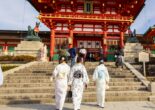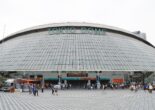It was the original terminus of the first railway in Japan. Today, you can still see the station, and a steam locomotive on the other side of the tracks. But now, Shimbashi is more famous for its eateries – and as the place where the tale of the 47 ronin began. Read more here.
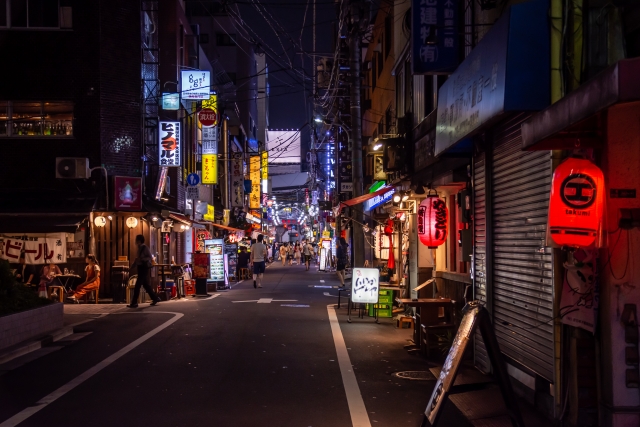
The first trains in Japan did not terminate at Tokyo Station. They went from Yokohama, then still the center of foreign trade in Japan. And they terminated in Shimbashi, then a very unassuming little way station on the way to Tokyo.
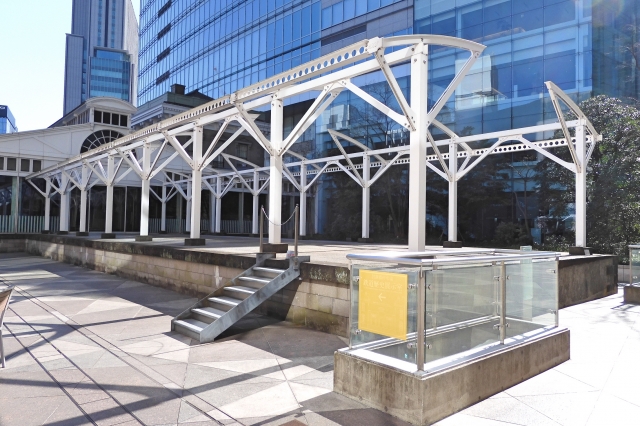
The old station building is still intact, although it has been turned into a restaurant. It is located near the northern edge of the Shiodome skyscraper district, which was built on top of what once was the main railyard of Tokyo.
Sandwiched between new and old Shimbashi
Today, Shimbashi station sits in the middle between the old Shimbashi area and the brand-new Shiodome area, both an entertainment and office area with several theaters, famous for playing Disney musicals. But it is also the gateway to the Odaiba area, the futuristic part of Tokyo built on artificially created islands in Tokyo Bay.
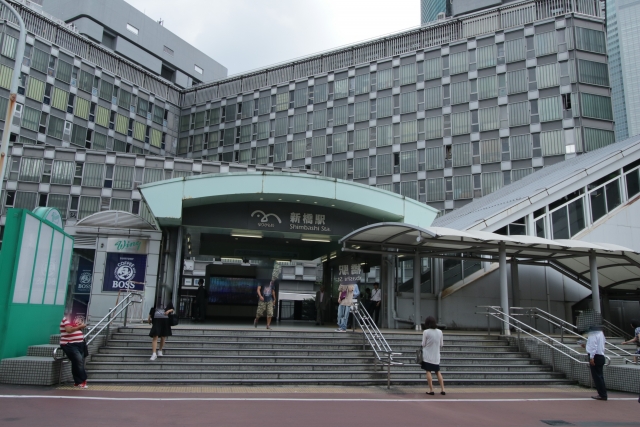
This is thanks to the Yurikamome, a driverless train running from Shimbashi station on elevated tracks across the Rainbow Bridge and into the futuristic Odaiba cityscape.
Steam Locomotive Square
There is another memorial to the transportation history of Tokyo on the other side of Shimbashi station. There is an old steam locomotive parked in the middle of the station square. It is a favorite with local and visiting children (although you are not allowed to climb onto it or play there).
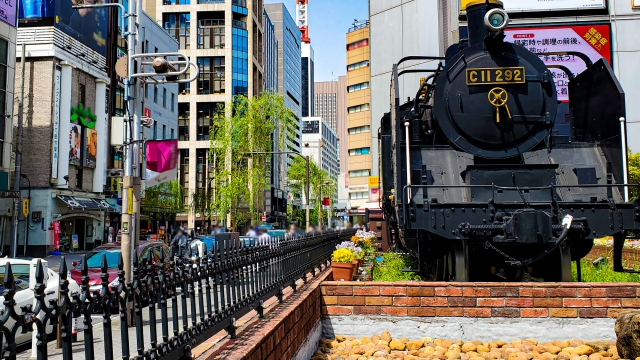
But since one of the commercial TV channels in Japan has its headquarters in nearby Shiodome, it is a frequent backdrop in TV interviews with ”salarymen” regarding questions of the day.
Shimbashi, and even more so Shiodome, is home to several big corporate offices — and the Shimbashi area is where the office employees go for their dinner, or after-work, or after-work dinner.
Reasonably Priced Eateries
The area near the station is full of small reasonably-priced eateries (serving more beer than food) catering to office workers and civil servants on their commute home. The restaurant area, in particular the part under the railway arches, merges seamlessly into the restaurant area around Yurakucho station.
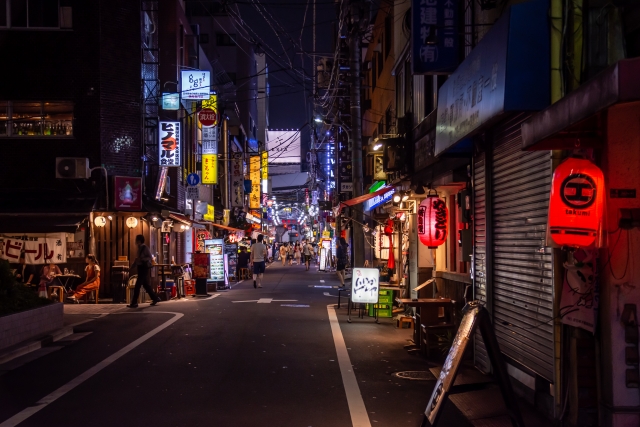
The area around the station (and under it, because there are restaurants in some of the tunnels connecting the shopping centers as well) is a prototypical salaryman restaurant area, full of small bars and simple restaurants.
Gradual western gentrification
If you walk to the west, the restaurants gradually gentrify. Many of the places around the area are directed to the residents of the many condominium buildings that have grown up around the area, culminating in the recent Toranomon Hills development, the only place where you will find a silver version of Doraemon, the cat robot from the future, deployed as a mascot. Other than that it is a prime example of the developments by the Mori Group, the biggest property developer in Tokyo and also behind the Roppongi Hills development, which consists of much more than the highrise building itself.
If you are taking the subway, the Hibuya line is the easiest connection between Toranomon and Roppongi, and if you continue a couple of stations, to Ebisu (with the brewery museum and microbrewery), and the Yamanote Line.
Start of the 47 Ronin
What is today the Shimbashi area was mostly daimyo palaces and residences of their servants and retainers until the 19th century when the modern development of Edo into Tokyo began. It does not have much in terms of historical memories, and the only notable shrine in the Shimbashi area is the Karasumori shrine, known for its color-coded omikuji (or future predictions).
However, Shimbashi today may be known as the home of salarymen, but it was here that one of the most famous incidents in Japanese history started, and that has spun off countless manga, anime, movies, and TV shows — even an opera. It was here in what today is the middle of an office area that the master of the 47 Ronin killed himself.
Unassuming Stone Pillar in Shimbashi
Today, the site is marked by an unassuming stone pillar with deeply engraved characters. It looks like so many other similar stone pillars spread out around Tokyo that if you did not know that this particular one was the source of one of the most celebrated events in Japanese history, you would probably walk past it without giving it a second thought.
The event was the revenge of the 47 retainers of a feudal lord, who were to manage the reception in Edo by a delegation from the Imperial Court in Kyoto. While the Bakufu (the government if the shogun) held the real power, it was in theory because that power was assigned by the Emperor. A delegation from the Emperor had to be received according to strict protocol and with all proper ceremonies observed.
Mismanaged Superior
The lord somehow mismanaged not the reception, but his superior officer, for unclear reasons. The result was that they did not see eye to eye, and eventually, their relationship became so bad that the lord drew his short sword on the official and cut him in the face.
This was a serious infraction, mostly because the lord had drawn his sword in the shogun’s palace. Violence was common in the Edo era, and duels often happened (provided the parties had permission from their lords). After all, they were samurai and could kill anyone.
Ritual suicide mercy killing
But not in the shogun’s palace. The punishment for drawing your blade in the palace was death, but the sentence was commuted to seppuku, the ritual samurai suicide.
When he committed suicide, not only did he lose his life. All loyalties were dissolved and all properties were confiscated. His retainers were made masterless and in theory, supposed to seek a new lord to pledge their loyalty. They were turned into ronin, masterless samurai.
47 of his retained samurai felt that their now-dead master had been wronged and that they should seek revenge on the official who was on the other side of the incident.
One Year of Plotting in Shimbashi’s History
They plotted for a year, hiding their preparations and loyalty by pretending to be worthless drunks. These 47 ronin then attacked the home of the government official (which was heavily defended by his retainers), decapitated him, and carried the head to the grave of their master (there are still occasional TV shows following the route, trying to figure out how you carry a severed head through the busy streets).
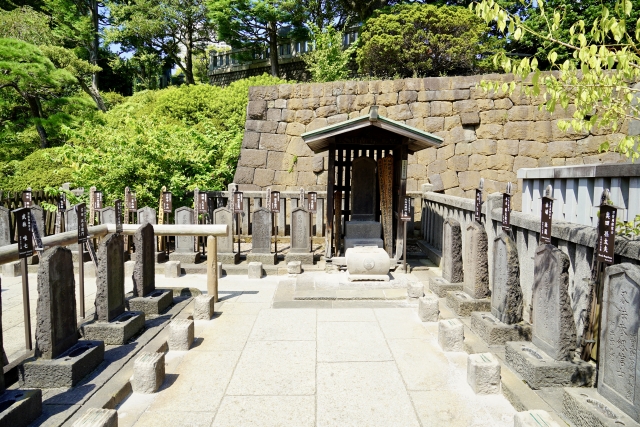
The head delivered, and those who had survived (all except one who was sent to their home province to inform about the deed) killed themselves on the grave of their master. Today, their graves still surround his.
Stay tuned for more exciting content like this! Follow us on our social media platforms and check out our blog regularly to stay updated on the latest news, trends, and insider stories from Japan. Don’t miss out on future updates—sign up for our newsletter for exclusive content delivered straight to your inbox!
Related Articles
Warning: Undefined array key "sfsi_threadsIcon_order" in /home/veremosglobal/tokyoroomfinder.com/public_html/blog/wp-content/plugins/ultimate-social-media-icons/libs/controllers/sfsi_frontpopUp.php on line 165
Warning: Undefined array key "sfsi_blueskyIcon_order" in /home/veremosglobal/tokyoroomfinder.com/public_html/blog/wp-content/plugins/ultimate-social-media-icons/libs/controllers/sfsi_frontpopUp.php on line 170
Warning: Undefined array key "sfsi_bluesky_display" in /home/veremosglobal/tokyoroomfinder.com/public_html/blog/wp-content/plugins/ultimate-social-media-icons/libs/controllers/sfsi_frontpopUp.php on line 266

